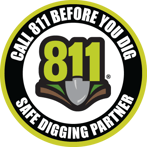Innovative Equipment Engineered to Last
Discover Barreto Manufacturing's 40 years of innovative, durable landscaping equipment, along with expert tips and local highlights for your projects.
How to Choose the Right Tiller: 3 Key Components to Choosing Tillers
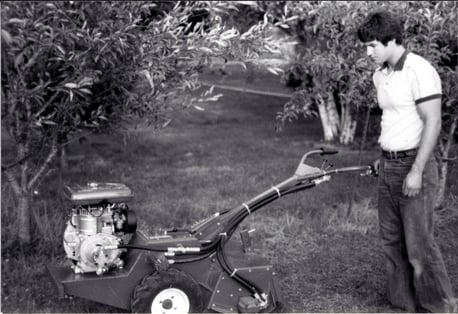 Tillers hold a special place in our hearts. As our first hydraulic innovation and the pinnacle product upon which Barreto was built, tillers are made to work and built to last. Many of our early machines are still in the field today, yielding an unmatched return on investment as reliable, durable pieces of equipment that withstand the test of time.
Tillers hold a special place in our hearts. As our first hydraulic innovation and the pinnacle product upon which Barreto was built, tillers are made to work and built to last. Many of our early machines are still in the field today, yielding an unmatched return on investment as reliable, durable pieces of equipment that withstand the test of time.
With many tiller styles available on the market, here are three key components to understand before renting a tiller or purchasing a tiller:
1. Tiller Categories
2. Drive Types
3. Tines
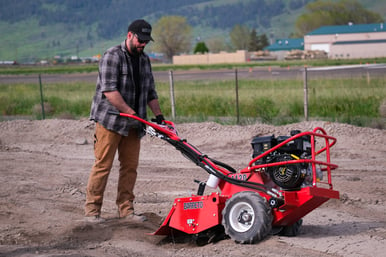 Tiller Categories
Tiller Categories
There are three major categories that lawn and garden tillers fall into: Front tine, mid tine, and rear tine.
In front tine tillers, the tines are located in front of the engine. Tines on mid tine tillers are directly beneath the engine, and in rear tine tillers (yep, you guessed it) the tines are located to the rear of the engine.
Front and mid tine tillers are light duty machines. They are usually smaller, with some models weighing as little as 100lbs. They are best suited for pre-worked soil as they are designed primarily for loosening prepared soil before planting. With the narrow design fitting well between garden rows, they are also often used for weed control. Front and mid tine tillers share many of the same qualities, with mid tine tillers boasting a bit more maneuverability.
Heavy duty rear tine tillers are larger, hardier machines. They are aggressive enough to cut through sod and till up hard unworked ground, while still being able to perform many of the same tasks as their smaller counterparts. The weight of these larger machines also provides an advantage, with some models weighing in at over 500lbs. They are less likely to skip and bounce in rocky or tough conditions. This creates a smoother tilling experience and decreases wear on the operator. Rear tine tillers are some of the only tillers on the market featuring all-hydraulic systems, making them an excellent choice for heavy and repeated use.
Drive Types
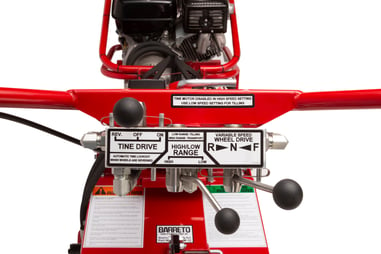 Drive types are an important factor to consider when browsing tillers. You will encounter mechanical drive and hydraulic drive tillers on the market.
Drive types are an important factor to consider when browsing tillers. You will encounter mechanical drive and hydraulic drive tillers on the market.
Front and mid tine tillers are almost exclusively mechanical drive, using mechanical components to transmit power from the engine. Mechanical drive tillers are smaller and lighter weight, and usually your least expensive option. However, they lack the durability and versatility of hydraulic drive tillers.
Hydraulic drive tillers are more durable, eliminating the mechanical components that tend to wear quickly and require costly repairs. Variable speed drive allows you to adjust the speed of the wheels to your tilling conditions. Hydraulic tillers also employ a relief valve system so that in the event the tines are obstructed and forced to stop, the pressure is relieved, avoiding breakage and wear. All hydraulic tillers are also capable of reversing the tine rotation, helping to dislodge rocks and debris.
Tines
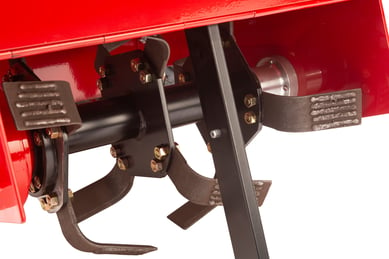 You will hear plenty about tines and their rotation when looking for tillers. Hardfaced tines are necessary for tillers that will see a great deal of use or are working in tough and rocky soils. The hardfacing can withstand more wear and increases the life of the tines.
You will hear plenty about tines and their rotation when looking for tillers. Hardfaced tines are necessary for tillers that will see a great deal of use or are working in tough and rocky soils. The hardfacing can withstand more wear and increases the life of the tines.
Rotation is extremely important to consider. Tillers can have forward rotating tines, counter rotating tines, and tines that rotate in both directions. Forward rotating tines rotate in the same direction the wheels turn. The forward rotation is less aggressive and is generally used to cultivate and aerate loose soils. Counter rotating tines rotate in the opposite direction of the wheels. They are able to till deeper and more aggressively, particularly on the first pass. This makes them more effective for tilling through root systems and breaking up sod.
Understanding these three components will help you make an informed decision when choosing your tiller, providing you with the best tilling solution for your project and your budget.
Remember to always call 811 before you dig, and locate all underground utilities. While tillers generally run at depths of 6-8 inches, multiple tilling passes, or improperly buried lines can pose a safety hazard on your jobsite.

